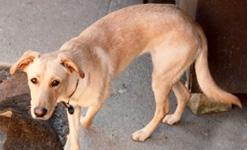How To Get An Anorexic Dog To Eat
 Not eating in a dog can be caused by a variety of medical and emotional conditions, so before taking any action at all, you want to be sure there really is a problem that needs addressing.
Not eating in a dog can be caused by a variety of medical and emotional conditions, so before taking any action at all, you want to be sure there really is a problem that needs addressing.
An otherwise healthy dog that refuses to eat for a day or two won’t be harmed by the experience, and if the dog is still active and drinking water, there’s no cause for alarm. However, noticeable weight loss or a period of extended refusal of food is definitely something worth talking to a vet about.
Supplying your dog with nutrients, especially if it is ill, is critical. Dogs need the resources to heal, even if they are not very active.
A liquefied diet of high-calorie blends (vets have these) or a homemade recipe run through a blender can be fed with a turkey baster. This technique is very helpful if your dog is not eating because of tooth pain or a mouth injury. Store-bought broths are generally too salty to use; read the label to find out.
Specific vs supportive therapy
Specific therapy means your vet treats an underlying condition that is causing it to stop eating. Supportive therapy is what you can do to encourage the dog to eat, even if you do not know the cause for the anorexic behavior.
We will not address specific therapies, since your vet will have to be involved in any care plan focused on a specific disease. Rather, we’ll look at supportive therapies and some tips to get your dog to start eating more normally again.
Change the diet
Dogs that are provided with the same food all the time may show interest when you introduce another type. Switching from dry to canned for awhile, or giving cat food is one way to spark eating.
Change the pattern of feeding
Some owners leave a bowl of food out all day and refill it when it gets low, expecting the dog to pace itself when it comes to eating. It may be better to put your dog on a schedule of two meals a day. The idea is to make the dog a little bit hungry before food is presented. Exercise also will help stimulate the dog to eat, since the natural pattern in dogs is to hunt/move quite a bit before they find something to eat.
The fussy dog
Some dogs stop eating their food because they prefer to eat what you are eating. Dog owners are notorious for “sharing” with their pets and if you dog learns they can beg for some of what you are eating, they might avoid their own food. This behavior can lead to weight loss when low-calorie or indigestible human food replaces the more appropriate dog food.
Stress
Just like humans, dogs who are under stress may give up eating. Stress in a dog can come from competition with other dogs in the house or anything that causes anxiety. A dog that is placed in a strange home may stop eating for a while from separation anxiety, for example.
There is no one answer that will solve anorexia in dogs. It becomes a matter of patient trial and error, seeking a veterinarian’s advice and not giving up.
 Eating Disorder Self Test. Take the EAT-26 self test to see if you might have eating disorder symptoms that might require professional evaluation. All answers are confidential.
Eating Disorder Self Test. Take the EAT-26 self test to see if you might have eating disorder symptoms that might require professional evaluation. All answers are confidential.